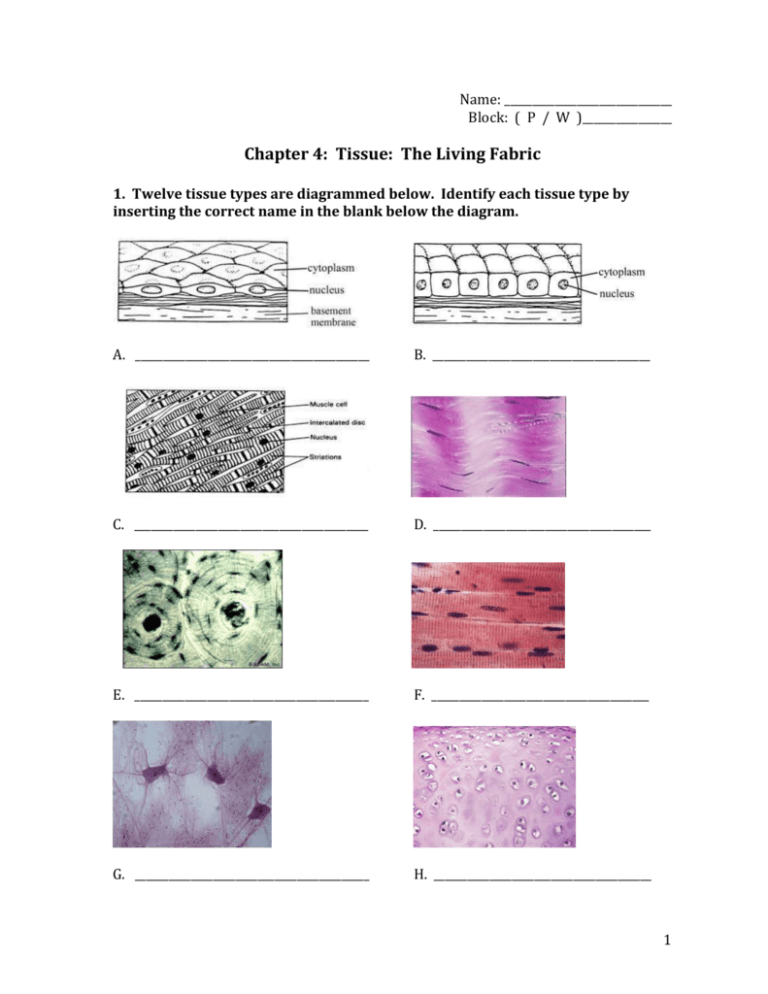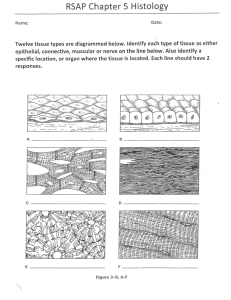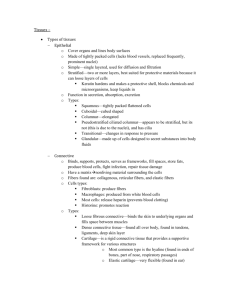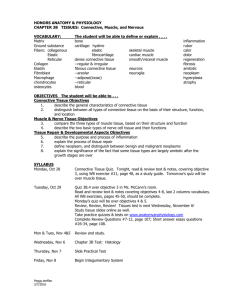Chapter 4 Homework Packet
advertisement

Name: ______________________________ Block: ( P / W )________________ Chapter 4: Tissue: The Living Fabric 1. Twelve tissue types are diagrammed below. Identify each tissue type by inserting the correct name in the blank below the diagram. A. __________________________________________ B. _______________________________________ C. __________________________________________ D. _______________________________________ E. __________________________________________ F. _______________________________________ G. __________________________________________ H. _______________________________________ 1 I. __________________________________________ J. _______________________________________ K. __________________________________________ L. _______________________________________ 2. Describe briefly how the particular structure of a neuron relates to its function in the body. 3. Using key choices, correctly identify the major tissue types described. Enter the appropriate letter of tissue type term in the answer blanks. Key Choices A. Connective B. Epithelium C. Muscle D. Nervous ______________________________ 1. Forms mucous, serous, and epidermal membranes ______________________________ 2. Allows for organ movements within the body ______________________________ 3. Transmits electrochemical impulses ______________________________ 4. Supports body organs ______________________________ 5. Cells of this tissue may absorb and/or secrete substances 2 Key Choices (same from other page) A. Connective B. Epithelium C. Muscle D. Nervous ______________________________ 6. Basis of the major controlling system of the body ______________________________ 7. The cells of this tissue shorten to exert force ______________________________ 8. Forms hormones ______________________________ 9. Packages and protects body organs ______________________________ 10. Characterized by having large amounts of nonliving matrix ______________________________ 11. Allows you to smile, grasp, swim, ski, shoot an arrow ______________________________ 12. Most widely distributed tissue type in the body ______________________________ 13. Forms the brain and spinal cord 4. Using key choices, identify the following specific type(s) of epithelial tissue. Enter the appropriate letter of classification term in the answer blanks. Key Choices A. Pseudostratified columnar (ciliated) B. Simple columnar D. Simple Squamous E. Stratified squamous C. Simple Cuboidal F. Transitional ______________________________ 1. Lines the esophagus and forms the skin epidermis ______________________________ 2. Forms the lining of the stomach and small intestine ______________________________ 3. Best suited for areas subjected to friction ______________________________ 4. Lines much of the respiratory tract ______________________________ 5. Propels substances (e.g., mucus) across its surface ______________________________ 6. Found in the bladder lining; peculiar cells that slide over one another ______________________________ 7. Forms thin serous membranes; a single layer of flattened cells 3 5. Epithelium exhibits many plasma membrane modifications. Figure 3-7 depicts some of these modifications. Correctly identify the following structures or regions by labeling the appropriate area or leader lines (A-I) using terms from the list below: Epithelial cell cytoplasm Connective tissue Epithelial cell nucleus Blood vessel Nerve fibers A. Apical region D. Cilia G. Epithelium B. Basement membrane E. Connective tissue H. Microvilli C. Capillary F. Desmosome I. Tight junctions 4 6. The three types of muscle tissue exhibit certain similarities and differences. Check the appropriate spaces in the following table to indicate which muscle types exhibit each characteristic. Characteristics Skeletal Cardiac Smooth 1. Voluntarily controlled 2. Involuntarily controlled 3. Banded appearance 4. Single nucleus in each cell 5. Multinucleate 6. Found attached to bones 7. Allows you to direct your eyeballs 8. Found in the walls of the stomach, uterus, and arteries 9. Contains spindle-shaped cells 10. Contains cylindrical cells with branching ends 11. Contains long, nonbranching cylindrical cells 12. Displays intercalated disks 13. Concerned with locomotion of the body as a whole 14. Changes the internal volume of an organ as it contracts 15. Tissue of the circulatory pump 7. Circle the term that does not belong in each of the following groupings. 1. Collagen Cell Matrix Cell product 2. Cilia Flagellum Microvilli Elastic fibers 3. Glands Bones Epidermis Mucosae 4. Adipose Hyaline Osseous Nervous 5. Blood Smooth Cardiac Skeletal 5 8. Using key choices, identify the following connective tissue types. Insert the appropriate letter of corresponding term in the answer blanks. Key Choices A. Adipose connective tissue D. Osseous tissue B. Areolar connective tissue E. Reticular connective tissue C. Dense fibrous connective tissue F. Hyaline cartilage ________________________________ 1. Provides great strength through parallel bundles of collagenic fibers; found in tendons ________________________________ 2. Acts as a storage depot for fat ________________________________ 3. Composes the dermis of the skin ________________________________ 4. Forms the bony skeleton ________________________________ 5. Composes the basement membrane and packages organs; includes a gel-like matric with all categories of fiber and many cell types ________________________________ 6. Forms the embryonic skeleton and the surfaces of bones at the joints; reinforces the trachea ________________________________ 7. Provides insulation for the body ________________________________ 8. Structurally amorphous matrix, heavily invaded with fibers; appears glassy and smooth ________________________________ 9. Contain cells arranged concentrically around a nutrient canal; matric is hard due to calcium salts ________________________________ 10. Forms the stroma or internal “skeleton” of lymph nodes, the spleen, and other lymphoid organs 6 Tissue Repair 9. For each of the following statements about tissue repair that is true, enter T in the answer blank. For each false statement, correct the underlined words by writing the correct words in the answer blank. ________________________________ 1. The nonspecific response of the body to injury is called regeneration. ________________________________ 2. Intact capillaries near an injury dilate, leaking plasma, blood cells, and antibodies, which cause the blood to clot. The clot at the surface dries to form a scab. ________________________________ 3. During the first phase of tissue repair, capillary buds invade the clot, forming a delicate pink tissue called endodermal tissue. ________________________________ 4. When damage is not too severe, the surface epithelium migrates beneath the dry scab and across the surface of the granulation tissue. This repair is called proliferation. ________________________________ 5. If tissue damage is very severe, tissue repair is more likely to occur by fibrosis, or scarring. ________________________________ 6. During fibrosis, fibroblasts in the granulation tissue lay down keratin fibers, which form a strong, compact, but inflexible mass. ________________________________ 7. The repair of cardiac muscle and nervous tissue occurs only by fibrosis. 7 DEVELOPMENTAL ASPECTS OF CELLS AND TISSUES 10. Correctly complete each statement by inserting your responses in the answer blanks. ________________________________ 1. ________________________________ 2. ________________________________ 3. ________________________________ 4. ________________________________ 5. ________________________________ 6. ________________________________ 7. ________________________________ 8. ________________________________ 9. ________________________________ 10. ________________________________ 11. ________________________________ 12. ________________________________ 13. ________________________________ 14. ________________________________ 15. ________________________________ 16. ________________________________ 17. ________________________________ 18. ________________________________ 19. ________________________________ 20. During embryonic development, cells specialize to form _(1)_. Mitotic cell division is very important for overall body _(2)_. All tissues except _(3)_ tissue continue to undergo cell division until the end of adolescence. After this time, _(4)_ tissue also becomes amitotic. When amitotic tissues are damaged, they are replaced by _(5)_ tissue, which does not function in the same way as the original tissue. This is a serious problem when heart cells are damaged. Aging begins almost as soon as we are born. Three explanations of the aging process have been offered. One states that _(6)_ insults, such as the presence of toxic substances in the blood, are important. Another theory states that external _(7)_ factors, such as X-rays, help to cause aging. A third theory suggests that aging is programmed in our _(8)_. Three examples of aging process seen in all people are _(9)_, _(10)_, and _(11)_. Neoplasms occur when cells “go wild” and the normal controls of cell _(12)_ are lost. The two types of neoplasms are _(13)_ and _(14)_. The _(15)_ type lends to stay localized and have a capsule. The _(16)_ type is likely to invade other body tissues and spread to other (distant) parts of the body. To correctly diagnose the type of neoplasm, a microscopic examination of the tissue called a _(17)_ is usually done. Whenever possible, _(18)_ is the treatment of choice for neoplasm. An overgrowth of tissue that is not considered to be a neoplasm is referred to as _(19)_. Conversely, a decrease in the size of an organ or tissue, resulting from loss of normal stimulation, is called _(20)_. 8







